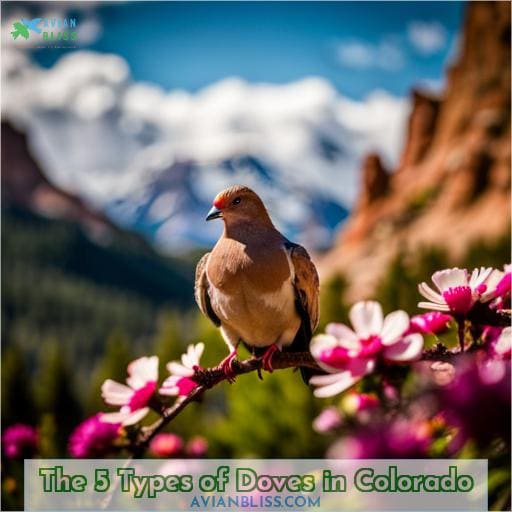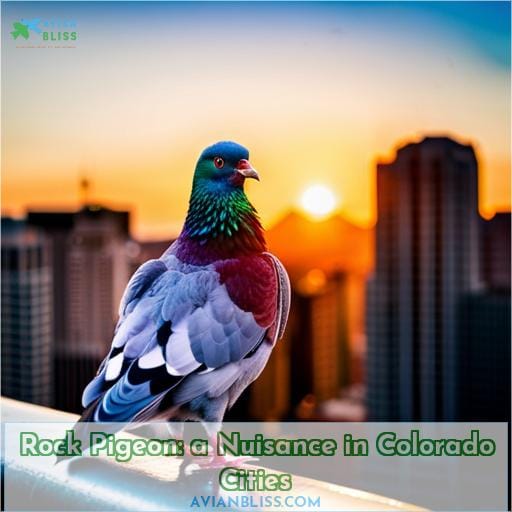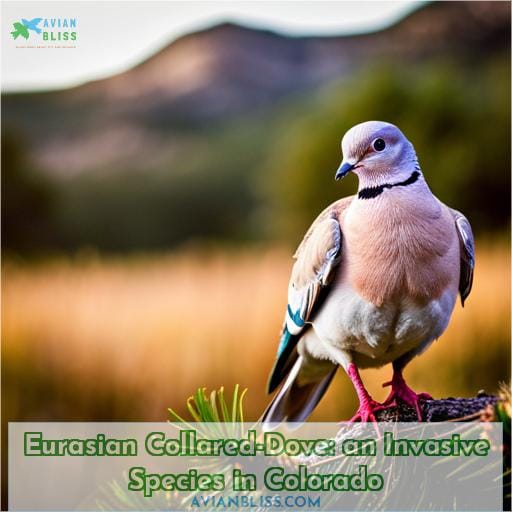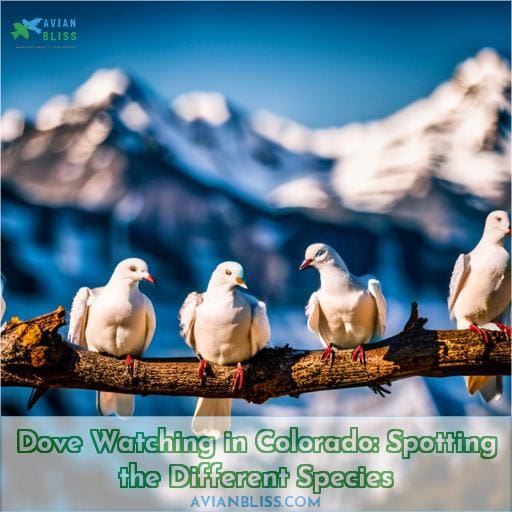This site is supported by our readers. We may earn a commission, at no cost to you, if you purchase through links.

Although small, their serene spirits and swift wings bring bliss. Let’s explore habits, habitats, and havens of these gentle avians across the Centennial State. Whether scanning treetops or cultivating bird-friendly spaces, you’re sure to spot rock pigeons pottering about town, mourning doves mingling in meadows, and Eurasian collared-doves elevating the energy around Colorado.
Table Of Contents
- Key Takeaways
- The 5 Types of Doves in Colorado
- Mourning Dove: Colorado’s Most Common Dove
- Rock Pigeon: a Nuisance in Colorado Cities
- Eurasian Collared-Dove: an Invasive Species in Colorado
- White-winged Dove: Adapting to Urban Habitats
- Band-tailed Pigeon: a Forest Dweller in Colorado
- Dove Watching in Colorado: Spotting the Different Species
- Exploring Colorado’s Avifauna: Doves’ Role in the Ecosystem
- Conclusion
Key Takeaways
- Mourning Dove: Gray with spots, coos, nests in shrubs, feeds on ground seeds, widespread, year-round, in open areas.
- Rock Pigeon: Urban, coos, nests on ledges, worldwide, nests on ledges, urban nuisance.
- Eurasian Collared-Dove: Sandy-brown, black neckband, competes, disease carrier, causes crop damage, invasive, urgent action needed.
- White-winged Dove: Pale gray-brown, white wing stripe, migrates, urban feeder, urban adapter, pale plumage.
The 5 Types of Doves in Colorado
The five types of doves you can find in Colorado are Mourning Doves, Rock Pigeons, Eurasian Collared-Doves, White-winged Doves, and Band-tailed Pigeons. As you explore the diverse landscapes across the state, you can observe and identify the unique features of each species with a keen eye and some patience.
Mourning Dove
You’ll easily spot the grayish mourning dove with black spots on its wings perched on your backyard fence or pecking along the ground, thanks to its ubiquity across Colorado.
- Coos owl-like sounds.
- Nests in shrubs and trees.
- Feeds on seeds on the ground.
The mourning dove’s soft cooing and ground feeding make it a familiar backyard visitor.
Rock Pigeon
Boom, bup-bup, there’s a plump Rock Pigeon cooing softly in the gutter, making a right nuisance of itself around urban areas despite its pretty plumage. Established worldwide, their urban adaptability enables them to thrive alongside us.
Pigeons roost communally, constantly seeking handouts. Though their droppings create sanitation issues, we must appreciate their resilience and beauty.
Eurasian Collared-Dove
Bet you all have spotted the sandy-brown dove with a black neck band wandering around cities and farms. This invasive Eurasian Collared Dove has adapted well to urban habitats, outcompeting native doves at bird feeders.
Managing their spread is crucial to protecting Colorado’s doves. Their urban lifestyle facilitates quick expansion across the state. Limiting access to bird feeders can help native doves survive among these invaders.
White-winged Dove
You’d spot the pale grayish-brown White-winged Dove with its telltale white wing stripe and black cheek patch visiting feeders in Colorado cities before hooting its signature coos. Greyish-brown and blending in with city birds, the White-winged Dove frequents feeders at homes.
They have an unusual song and visit your yard during migrations, then fly south to Mexico. Keen eyes notice the white wing stripes set against otherwise ordinary feathers.
Band-tailed Pigeon
You’ll spot large band-tailed pigeons with pale tail bands and white neck rings foraging through Colorado’s forests. Their unique behavior, group dynamics, and resonating coos contribute to their allure.
Group Dynamics:
These sociable doves travel in cohesive flocks, adding a sense of camaraderie to the forest.
Vocalizations:
The soft, deep coos of band-tailed pigeons resonate through the woods, creating a melodic symphony that echoes their presence.
Habitat Preferences:
Preferring the shelter of forests and suburban areas, these doves thrive in the serene beauty of Colorado’s diverse landscapes.
Conservation Concerns:
While not as invasive as some counterparts, monitoring their populations is essential to ensure their continued harmonious existence within the ecosystem.
Mourning Dove: Colorado’s Most Common Dove
Located throughout Colorado, the Mourning Dove is the state’s most widespread and familiar dove. Look for these mid-sized grayish-brown birds with black spots on their wings as they forage for seeds on the ground or visit platform feeders filled with millet and sunflower seeds to attract them to your backyard.
Range Map
You can readily render range maps revealing resident dove regions.
| Season | Distribution |
|---|---|
| Spring | Widespread across the state of Colorado |
| Summer | Western counties have higher populations |
| Fall | Southeastern counties see more as they migrate |
| Winter | Mourning doves can be found statewide year-round |
These adaptable birds frequent backyards and bird feeders across Colorado. Their range spans urban and rural areas, though breeding sites and food sources influence local numbers.
Behavior and Habitat
Let’s see doves hopping along the ground or soaring through the blue skies as you stroll Colorado’s open spaces.
- Cooing from the treetops
- Pecking at seeds on the ground
- Sunning wings outstretched
- Darting to nests and fledglings
- Foraging among the wildflowers
The mourning dove thrives in open rural areas with scattered trees or shrubs for nesting and roosting. It forages on seeds and grain on the ground and has a distinctive soft, plaintive cooing vocalization.
Though they migrate south for the winter, mourning doves can be spotted in Colorado year-round.
Attracting Mourning Doves to Bird Feeders
To attract mourning doves to bird feeders, provide millet and shelled sunflower seeds, as these are preferred. Place the feeders in open areas near trees or shrubs to allow for quick escape. Continue feeding them through the summer when they are raising their young.
Additionally, add native plants like meadow grasses to supplement their natural food sources and provide cover. Mourning doves favor open habitats with scattered trees and will visit regularly if the habitat and food meet their needs.
Rock Pigeon: a Nuisance in Colorado Cities
As Mourning Doves fade into urban backgrounds, you’ll notice another bird underfoot. Fat and splotchy, Rock Pigeons waddle through city centers worldwide. You’ll know them by slate-gray wings with glossy green and violet trim and two dark wingbars.
Though their soft coos are pleasant at dawn, these opportunistic birds quickly become nuisances. They nest on ledges and billboards, coating buildings in guano. You’ll see them loitering in parking lots and swarming park lawns for breadcrumbs.
Controlling their numbers is tough – pigeon spikes on ledges and traps help somewhat. Though urban living suits them fine, Rock Pigeons descended from cliff dwellers.
While problematic, these resourceful birds remind you what survives and thrives among humans.
Eurasian Collared-Dove: an Invasive Species in Colorado
You’re sure to notice the sandy brown Eurasian collared-doves with black neck collars if you look closely at Colorado’s doves, aren’t you? Their rapid spread is concerning for several reasons:
- They compete with native species for food and nesting sites.
- Collared doves carry diseases that could spread to native birds.
- Large flocks can damage agricultural crops.
We must act now to manage Eurasian collared-doves in Colorado. Removing food sources, controlling populations, and monitoring spread into new areas will help reduce impacts.
And most importantly, we must prevent further accidental introductions of invasive species that disrupt our native ecosystems.
Though an introduced species, the Eurasian collared-dove has become part of Colorado’s diverse avifauna.
White-winged Dove: Adapting to Urban Habitats
As strong fliers with tough constitutions, White-winged Doves have adapted well to the urban habitats cropping up across your state. You may spot their pale grayish-brown plumage and distinctive white wing bands in cities and suburbs where they frequent backyard feeders.
These doves breed in dense trees and shrubs before migrating south to Mexico for winter. Their musical cooing sounds more melodic than the mourning dove’s haunting call. White-winged Doves roost communally and forage primarily on seeds and grains on the ground, making them a common sight pecking in grassy yards and parks.
With flexible diets and the ability to thrive near humans, they exemplify how some avian species can flourish amid urbanization.
Band-tailed Pigeon: a Forest Dweller in Colorado
Didn’t the band-tailed pigeon’s striking plumage and deep coos catch your eye as it foraged for berries in Colorado’s mountain forests? Its adaptability lets it thrive both in deep woods and backyard feeders, but could encroaching development limit this resourceful bird’s range?
This forest-dwelling dove favors coniferous and mixed woodlands up to 10,000 feet in elevation. You may spot it singly or in small flocks, feeding on seeds and fruits of trees like dogwood, madrone, and elderberry.
Though still common, habitat loss is a concern. Follow these tips to aid conservation efforts:
- Plant native berry bushes and conifers on your property.
- Keep cats indoors to reduce predation.
- Use bird-safe building materials like fritted glass.
- Limit pesticide use which reduces food sources.
- Advocate for urban green spaces and corridors.
With care, both rural and urban residents can provide sanctuary for this graceful dove and other wildlife.
Dove Watching in Colorado: Spotting the Different Species
Spotting doves across Colorado can be a rewarding birdwatching experience if you know where to look. The state’s parks and refuges provide excellent opportunities to identify mourning doves, Eurasian collared doves, white-winged doves, and other species by their distinguishing features and behaviors.
Identifying Doves in Colorado
Seeing mourning doves cooing on your porch or collared-doves pecking at seed feels like a connection to Colorado’s wild heart. As you watch doves up close, pay attention to their behavior, vocalizations, and feeding habits to identify the species.
Our state hosts a diversity of doves, each with a unique range and distribution. Getting acquainted with your local doves creates an intimate bond with Colorado’s avifauna.
Species:
- Mourning Dove: Ground feeders, dust bathe. They produce soft, owl-like coos.
- Eurasian Collared-Dove: Gregarious and urban adapted. They have a rhythmic cooing call.
- White-winged Dove: Migratory and often found at backyard feeders. The males produce hooting coos.
- Band-tailed Pigeon: They travel in flocks and have deep, groaning coos.
- Rock Pigeon: Highly social and often roost on buildings. They have throaty coos.
Popular Locations for Dove Watching
To spot doves, head over to the productive agricultural fields in the San Luis Valley.
- Invest in a good pair of binoculars to get a close view of their markings and behaviors.
- Look for mourning doves around farms with open fields and scattered trees.
- Time your visit during late summer when young doves are leaving nests.
- Attend birding festivals to find prime viewing spots and share sightings.
With preparation and strategic timing, Colorado’s agricultural valleys offer plentiful dove viewing opportunities.
Exploring Colorado’s Avifauna: Doves’ Role in the Ecosystem
You all can explore Colorado’s diverse avifauna and how doves uniquely contribute to the state’s ecosystem ecology.
Dove Species:
- Mourning Dove: Ground feeding, nesting in shrubs and trees. Form large roosts in winter.
- Eurasian Collared-Dove: Adaptable to urban areas, aggressive.
- Rock Pigeon: Roost and breed in buildings, bridges.
- White-winged Dove: Migrate between US and Mexico.
- Band-tailed Pigeon: Travel in flocks between mountains and foothills.
As seed dispersers, doves play a key role in plant propagation and forest regeneration.
Through competition and disease transmission, doves influence populations of other bird species. Collared-doves can negatively impact native mourning doves. Urban doves may require population management.
Promoting backyard habitat diversity helps support dove diversity. Observing local doves provides a window into the interconnected dynamics of Colorado’s rich bird communities.
Conclusion
Intriguingly, you’ll find five types of doves across Colorado – so next time you’re birding, keep an eye out for their distinct features. Though colorful and charismatic species rule our fascination, remember that common birds like doves play key roles.
As you explore Colorado’s diverse habitats, appreciate how doves in Colorado distribute seeds, interact with other wildlife, and contribute to the state’s rich avifauna.











